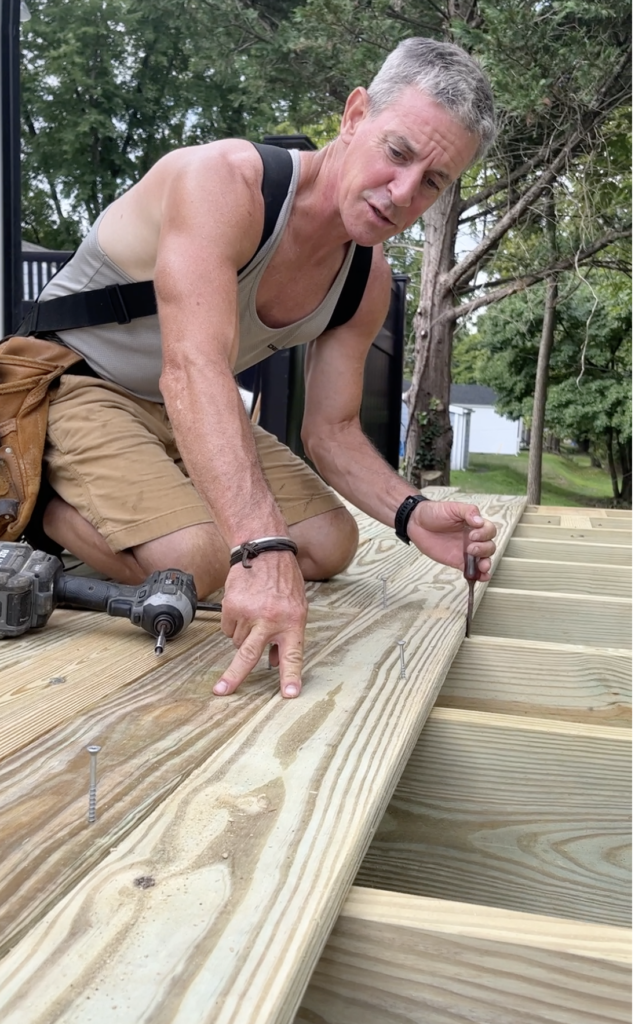
Should pressure treated decking be gapped? Or should pressure treated decking be installed with no gap? There’s been a big debate over on our YouTube channel lately. Find out why we gap our pressure treated decking on a deck.
Gap pressure treated decking?
If you’re working with pressure treated Southern Pine–the stuff I’ve used my entire career–it comes, as my lumberyard describes it: Wet.
What “wet” means is a 25% or so moisture content. That moisture comes from the manufacturing process.
A Southern Pine board goes from un-pressure treated to pressure-treated with chemicals that ward off bacteria, fungi and the like by taking a ride with many other boards in a 100-yard-long pressure cookers. They go in as blonde boards and come out the other side, green and ready for ground contact.
And, if you’re using PT Southern Pine and working in the Eastern half of the US, no gap. It is so soaked when it gets to you, there is no amount of rain or snow that can bring it back up to its original moisture content.
Note: That the industry does this by the BILLIONS of board feet annually will never cease to amaze me.
Are there exceptions?
In short, we don’t gap pressure treated lumber that’s wet. Even though the PT decking you get may be low moisture content (like cedar that needs to be gapped), it’s not the norm.
My lumberyard, the great and mighty Niece Lumber calls it “wet” in their paperwork. And the boards we get from the lumberyard are almost totally clear of imperfections and dead straight, too.
For example, they are so wet that when I blow screws into the boards, liquid comes out. As a result, a chair leg would get snagged in it if I gapped decking that has moisture oozing out when a fastener is driven. You could see through it to the mud or whatever else is beneath the deck. And it just wouldn’t look right.
Why?
Because the way the chemical that makes PT last for decades gets into the material is in 100-yard long pressure cookers. In the case of Southern Pine, the chemical fuses with the lumber at a molecular level.
Southern Pine is a softwood species. That is not the case with the Douglas Fir—a medium density species mainly used West of the Mississippi River. The chemical can’t be driven all the way through, so it is incised (slits are milled into it) to improve chemical penetration, but it doesn’t get all the way in there.
Back to Southern Pine. I’ve gotten Southern Pine material so wet when I seat a screw it almost splashes.
The lumber industry has achieved a marvel when it comes to deck boards. They produce thousands of miles of decking every year, ship them to lumber yards and big boxes and have figured out that when some podunk deck builder like me installs them tight, the shrink and gap to a near perfect ?-inch.
Fit boards tight when they aren’t perfectly parallel.
When boards aren’t lining up perfectly parallel, I reach for my chisel and use a method I call the Chisel Trick. I put the chisel at an angle from the front of the deck board, and then pull it back toward me. (Yes, all of the woodworkers out there are cringing. However, I keep this chisel in my tool belt for this specific kind of task. It’s OK to relax now.)
The angle and pulling it closes up the gap between the boards, and then I use my free hand to drive a few fasteners. The boards are secure, so I can keep the fastener pattern along the rest of the board.
But install with no gap–and the Chisel Trick–and SP dries to a perfect balance of gapped and comfortable to live with. Homeowners are happy, too.
What do you think?
Share your opinion about gapping decking boards in the comments below or send us an email if you have questions about gapping deck boards or another home improvement project.
If you want to join in on the conversation on YouTube, head over to the comments in this video about gapping pressure treated decking. We’d like to know what you think.



